Johnny and I are prowling a glorified goat track near the Galiuro Mountains in southeast Arizona, ensconced in a fully loaded and air-conditioned Toyota FJ Cruiser. Burdened as we are by a trunk full of iced beverages, fresh eggs and bacon, sinfully thick sleeping pads, and the finest in folding chairs, we are nonetheless seeking the geographic rewards and solitude typically reserved for backpackers.
We’ve come to the Southwest because its vast acres of BLM land offer some of the most remote, scenic, and regulation-free hideaways in the Lower 48—perfect hunting ground in our quest for wilderness-flavored car camping. My partner, guidebook author Johnny Molloy, reminds me of a grizzled bird dog when it comes to this pursuit. One of the foremost camping authorities in America, the Johnson City, Tennessee, native logs 180 bag nights and puts 25,000 miles on his car annually researching his growing catalog of books (nearly 20, including eight state-specific camping guides). The guy knows campsites like Robert Parker knows wine.
I apply the brakes near a site with potential—a shade tree, a sweeping view, fuel for a fire.
“I’m not feeling it,” says Johnny. “Too exposed, and there’s no water.” Perfection in this quest will require patience. It’s not like backpacking, where the thought process at the end of a wearying day is blissfully simple: If there’s water to drink and reasonably level ground on which to pitch a tent, you’re done. Campsite selection from behind a windshield is just the opposite. There’s something about having four wheels at your disposal that unleashes an inner Goldilocks: This site’s too sunny, that one’s too windy, the next one’s not as pretty.
There are plenty of options here. We’ve targeted land governed by a recreational use policy summarized in four glorious words: “primitive, dispersed camping allowed.” That’s land-manager speak for “you’re in the boonies, son, and there ain’t a fee station or ranger for miles.” But loneliness isn’t enough. We forge on to the high aspen groves of Apache-Sitgreaves National Forest, where the quaking leaves offer a soundtrack rarely disturbed by combustion engines. Another site is disqualified by the old cattle fence marring the view.
“Too much barbed wire,” says Johnny.
Giving up on the Galiuros for now, we relocate south, to the Chiricahua Mountains. Our next sky-island destination is at the end of a 27-mile dirt road, and close to ridge-top trails. It’ll do for a night, but Johnny eliminates it immediately from championship material.
“Too tame.”
The next day, we decide we need to do more recon, and stop in the tiny town of Patagonia. Johnny sees some off-duty wildland firefighters and figures they should know the area better than most. He swings into action with his disarming Southern drawl: “Ahm not from around here, and Ah wuz wunderin’…”
“Gardner Canyon is the one,” volunteers a young, stocky member of the crew. “You’ll have nearby hiking and even a running creek.” Taking his advice, we head back out on the road. Gardner Canyon accesses the west side of the Mt. Wrightson Wilderness, a chunk of the Santa Rita Mountains laced by 35 miles of trail and lorded over by the pyramidal 9,453-foot Mt. Wrightson. We pause to close a cattle gate at Tunnel Spring as we head up the canyon, cross the Arizona Trail, then gingerly splash through Gardner Creek. Hard by the creek, I see it: a promising site beneath the outspread arms of a sycamore, with Mt. Wrightson visible through the canopy.
We pitch our tent, string a hammock, and take a short hike on the Arizona Trail, where a blanket of tawny grasslands unfurls to the base of the Mustang Mountains. Back at camp, I clean off in the icy stream and crack a cold beer. A whippoorwill whistles from the opposite bank. The aroma of burning juniper drifts on a cool breeze.
For the next three days, we’re torn between hiking and relaxing, between adventure and siesta, which at the end of our quest brings the perfection we've been seeking into focus. What we’ve been looking for, I realize, is a yin-yang nirvana, a site with surroundings so magnificent your muscles beg to explore but so peaceful your brain begs to shut down.
Johnny and I will enjoy the push-pull of our paradise beside Gardner Creek until the siren call of something better gets us back in the Toyota. After all, some of the best places in life are just a few miles down that rocky, rutted road.
Get there: From Sonoita, take AZ 83 21 miles to Gardner Canyon Rd. Turn west, and drive nine miles to look for campsites just before and after the road crosses Gardner Creek.
Map: Green Trails Map Santa Rita Mountains ($12, Green Trails Maps)
Coordinates: 31.7016, -110.7931
Contact: Coronado National Forest; (520) 378-0311
Camp Across the Country
Gardner Canyon isn't the only car camping site with a backcountry feel. Head to one of these 15 spots for a wilderness experience without the foot fatigue.
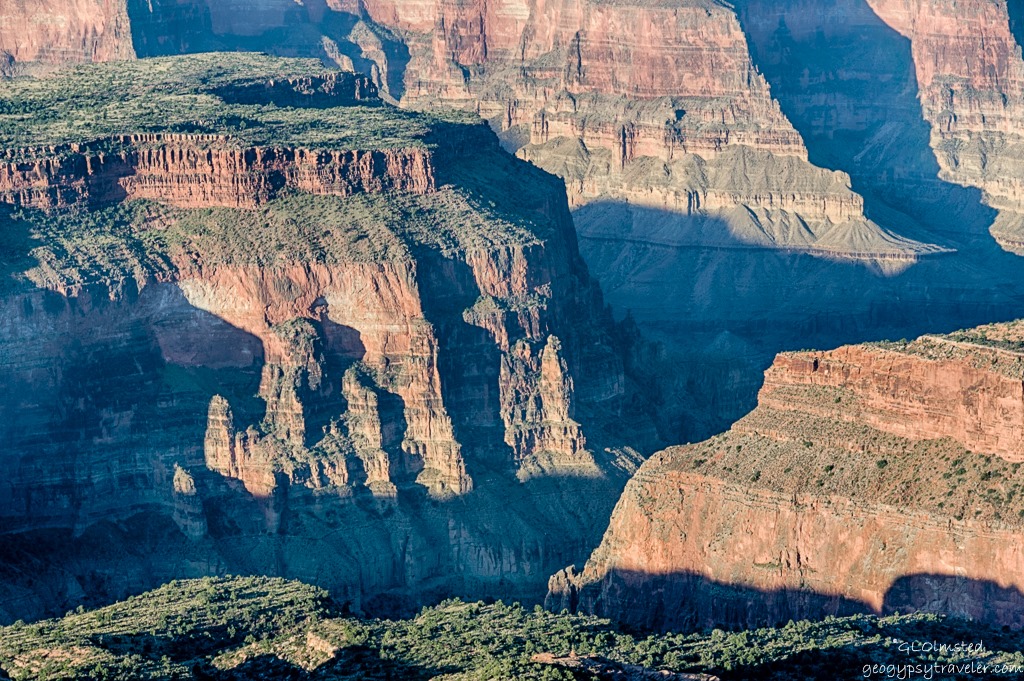
Crazy Jug Point
Grand Canyon National Park
Head to the North Rim for this cliff-edge site.
Crazy Jug Point offers lip-of-the-canyon carside camping that blows away the notion that Grand Canyon grandeur comes with a crowd. Crazy Jug and nearby (and nearly as sweet) Timp Point are located on a sliver of ponderosa- and piñon-covered rim managed by Kaibab National Forest, which allows dispersed camping. Both lie at least 27 miles down a series of smooth dirt roads. Crazy Jug is the better choice: From camp, you can see the Colorado River coming out from behind the Powell Plateau, wrapping around Great Thumb Mesa, and winding far downstream. Plus, the Bill Hall Trail starts less than a mile west from camp. Dayhike plan: Descend Bill Hall two miles to the broad Esplanade 1,800 feet below. You can hear the roar of Thunder River, a gusher that bursts from the canyon wall, and see volcanic Mt. Trumbull and the rest of the Uinkaret Mountains rising to the west.
Get there From the Kaibab Plateau Visitor Center on AZ 67, head south 26.5 miles to FR 22. Turn right and go 10.5 miles to FR 206; turn left and drive one mile to FR 425. Take it to its end.
Coordinates 36.4271, -112.4036
Map Earthwalk Press Grand Canyon National Park ($10, Bored Feet)
Contact Kaibab National Forest; (928) 643-7395
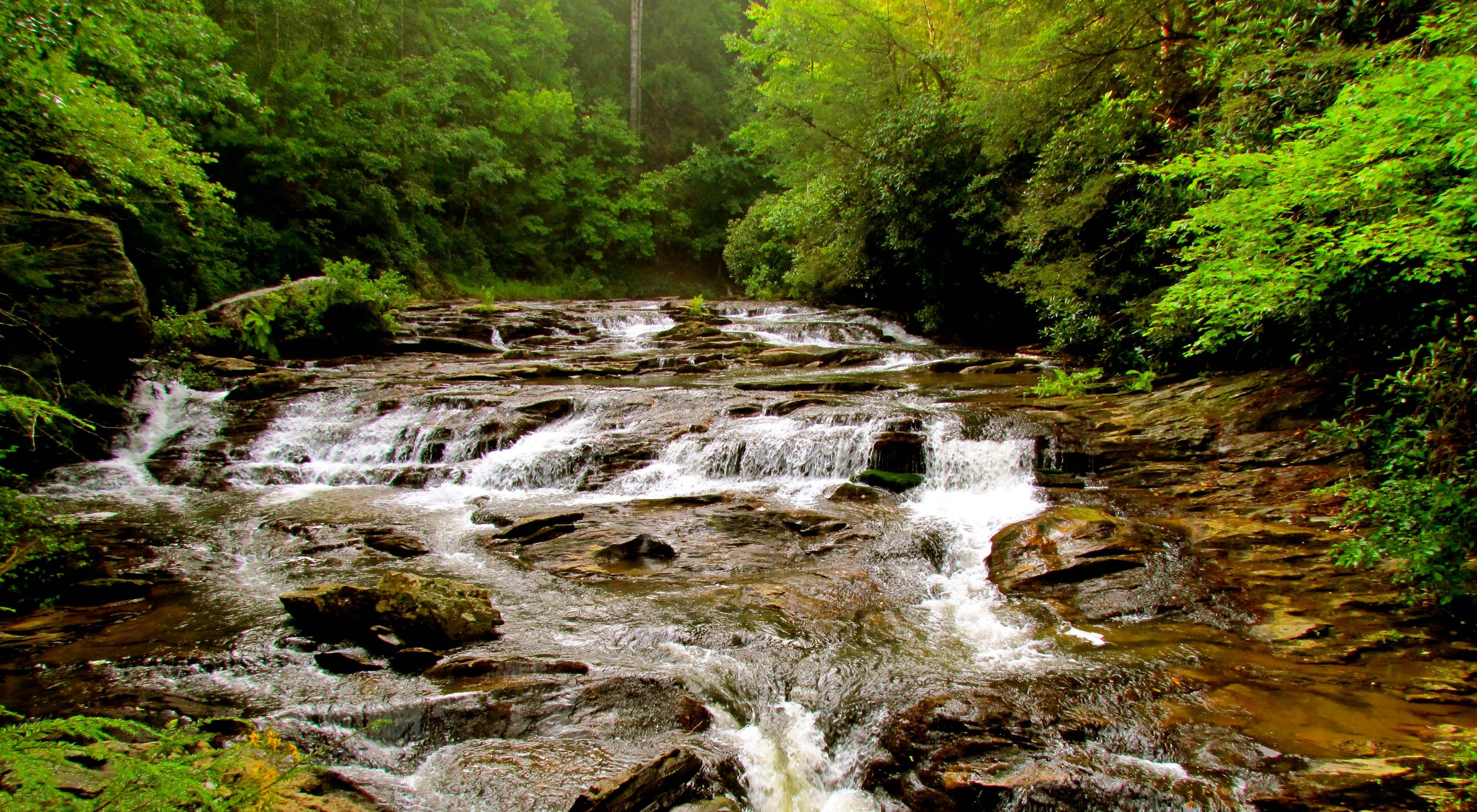
Noontootla Creek
Chattahoochee National Forest
Camp creekside near Georgia’s Springer Mountain.
From a common starting point on Springer Mountain, the Benton MacKaye and Appalachian Trails crisscross three times in their first few miles before finally parting ways. That double helix has created some top-notch hiking loops: the Benton MacKaye-Stanley Gap Loop and the Free Knob Loop, each easily accessed from pull-off campsites tucked in the rhododendrons beside boisterous Noontootla Creek. “The Noontootla is a beautiful creek with calendar-worthy cascades and trophy-size trout,” says Gil Carter, co-owner of Copperhill Outfitters just over the border in Copperhill, Tennessee. Campsites along the Noontootla, reached by Forest Service Road 58, are spacious, private, and decked out with fire rings and log seats. Five sites sit within babble-distance of the creek on a bench just below (and out of site of) the road. And since the sites are each separated by about a quarter-mile of hemlock and poplar, you’ll have ample buffer from the occasional Boy Scout troop. The only real problem? Deciding which route to hike to Springer Mountain, the southern terminus of the Appalachian Trail. Springer lies four miles south of camp via the AT, and six miles via the Benton MacKaye (the latter generally sticks to higher and drier ground). Best bet: See them both and make it a 10-mile loop.
Get there From Ellijay, take GA 52 4.8 miles east to a left on Big Creek Rd. Go 15.1 miles to FR 58. Turn right. After you enter the Blue Ridge Wildlife Management area, camping is allowed in designated areas along the creek.
Coordinates 34.6376, -84.1950
Map Springer and Cohutta Mountains ($12, National Geographic Maps)
Contact Chattahoochee-Oconee National Forests; (770) 297-3000

Hopkins Prairie
Ocala National Forest
Escape to Florida’s finest gator-free swimming holes.
The Florida Trail Association calls Ocala National Forest “the heart and soul” of its 1,400-mile namesake. Which, if you like your metaphors extended, would make Juniper Prairie Wilderness the trail’s left ventricle. A combination of prairie, pine islands, crystalline ponds, and—believe it or not—rolling sand hills with actual views, make it a favorite among local backpackers. Johnny Molloy, author of Hiking Trails of Florida’s National Forests, Parks, and Preserves, suggests setting up on any suitable pullout or spur road near the intersection of the Florida Trail and Forest Road 65 at the north end of Hopkins Prairie, an enormous seasonal marsh bounded by pines. From camp, the FT edges around Hopkins for four miles on its way south to Juniper Spring. Make the 18-mile round-trip to spring-fed Hidden Pond, take a cool (gator-free) swim, and be back by dinner; minimal elevation gain makes the big day doable.
Get there From the FL 19-FL 40 junction, head 9.2 miles north on FL 19 to a left at the Hopkins Prairie sign. Go two miles to a right at the next Hopkins Prairie sign and begin scouting for camping.
Coordinates 29.2954, -81.7269
Map Ocala North and South ($6, Florida Trail Association)
Contact Ocala National Forest; (352) 236-0288
Lower Crystal Lake
White River National Forest
Camp at 12,000 feet in Colorado ski resort sidecountry.
The backside of Breckenridge Ski Resort is a no man’s land. In winter, only small parties of expert skiers visit on powder days. And in the summer? Steep, unmarked roads and the popularity of nearby and easily-accessed Mohawk Lakes to the south keep this spot off the radar. Plus, sleeping at 12,000 feet isn’t for everyone (acclimatize in town if you are coming from the lowlands). But if you like your scenery decidedly alpine and your neighbors nonexistent (and you have a sturdy 4x4), this exposed, grassy site is a backpacker’s dream. Hike plan: Tackle an off-trail ascent of 13,852-foot Crystal Peak or just stroll two trail miles to skip stones at Upper Crystal Lake. Wind? Find sheltered sites within the trees near the road.
Get there From Breckenridge, take US 9 south 2.1 miles to Spruce Creek Rd. Turn right, and go 1.5 miles to Crystal Creek Rd. Turn right, and go 2.4 miles.
Coordinates 39.4358, -106.0887
Map Breckenridge/Tennessee Pass ($12, National Geographic Maps)
Contact White River National Forest; (970)468-5400

Forest Road 1205
Ozark National Forest
Get a front row seat to Arkansas’ finest falls.
The official-sounding “Richland Creek Campground” evokes visions of numbered sites and a host selling bundles of firewood. What you’ll really find: an inviting hodgepodge of free, first-come first-serve, creekside campsites next to a trailhead that leads to some of the state’s most spectacular falls and swimming holes. But you’ll have to fight temptation to make it this far. Forest Road 1205 (aka Falling Water Road) is packed with secluded sites beneath a lush oak and longleaf pine canopy—you won’t be unhappy if you succumb too soon, but we recommend you hold out for Richland Creek. Either way, be sure to take the three-mile unmarked trek (with occasional scrambling over smooth, living room-size boulders) to the confluence of Devil’s Fork Creek and Richland Creek. Twin Falls’ side-by-side, 25-foot cascades lie 2.5 miles in. Richland Falls is another 400 yards upstream. It drops just six feet, but it’s 40 wide. Find wadeable and swimmable pools all along the trail.
Get there From Russellville, take AR 7 37 miles north to Pelsor. Turn right on AR 16, and go 10 miles to a left on FR 1205 (gravel). It’s nine miles north to Richland Creek.
Coordinates 35.7527, -92.9386
Map USGS Quads Smyrna, Moore ($8 each)
Contact Ozark National Forest; (479) 964-7200
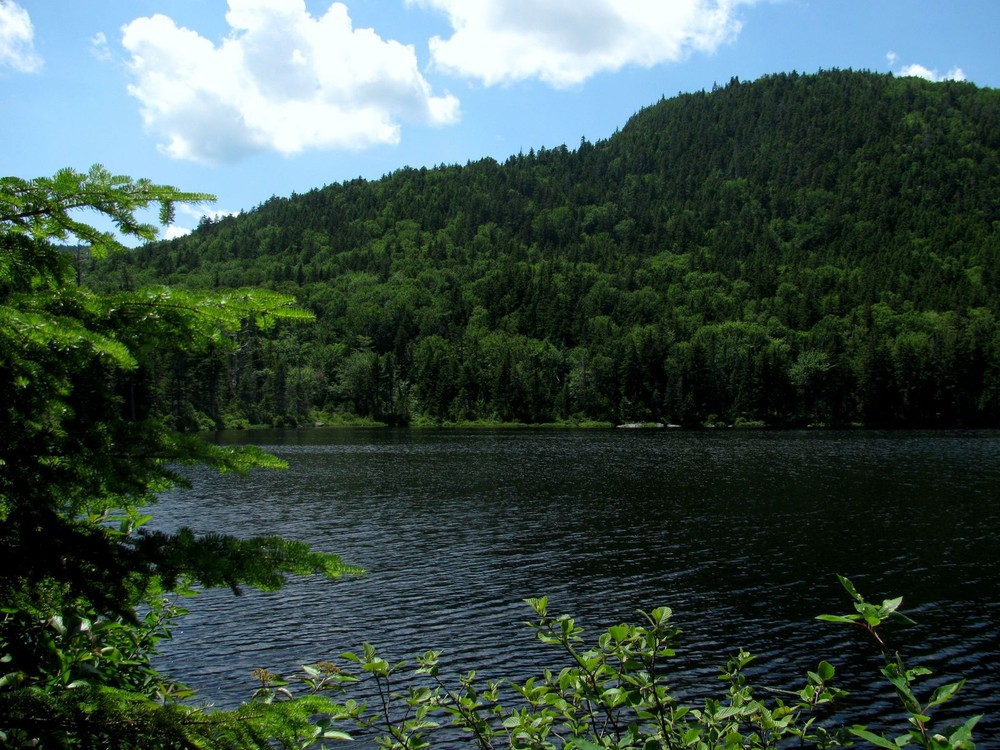
Pearl Ponds
Maine’s North Woods
Get campground luxury with backcountry solitude.
The first rule of driving the thousands of miles of forest roads that penetrate Maine’s North Woods: Logging trucks get the right of way. The second rule: The hundreds of rarely visited campsites up this way–like the four at Pearl Ponds–make a little truck-dodging worthwhile. Recently opened by the Appalachian Mountain Club, these isolated campsites combine the accoutrements of a campground (picnic tables, fire rings, outhouses) with the charms of the backcountry (access to five lakes and on-site canoes). There’s also an abundance of nearby hiking. Gulf Hagas, a 400-foot-deep gorge filled with gushing waterfalls, is the main event. See it on the Rim Trail, a nine-mile hike that begins a short walk from camp. Tack on an additional two miles to visit The Hermitage, a 35-acre stand of old-growth white pine untouched by lumberjacks.
Get there From Millinocket, take ME 11 15 miles south to a right turn into KI-Jo Mary Multi-Use Forest. Follow signs.
Coordinates 45.5148, -69.4044
Map AMC Katahdin Iron Works Summer Trails and Bike Routes (free, Appalachian Mountain Club)
Permit Required ($10/person/night, plus $10 gate fee)
Contact Appalachian Mountain Club; (207) 965-8135

Twisted Shoe
Big Bend National Park
Pitch a tent in one of Texas’s most remote campsites.
In 1787, an Apache chief known as Twisted Shoe led his warriors into battle against Spanish soldiers at the base of the Chisos Mountains, deep in the prickly Chihuahuan Desert. Today, his namesake camp—a lonely, ocotillo-lined site at the range’s southern foot—is still a pretty rough place. The summer sizzles like a tortilla on the griddle, and water is scarce. Nestled at the end of a 12-mile approach via a rough and rutted road, however, it’s the very essence of remote, and solitude is assured (it’s a single reservation-only site). Best plan: Pack plenty of agua, and come in late fall. Spend your first day exploring the buttes and verdant, mule deer-frequented valleys surrounding the site (which has a view of Chillocatal Mountain going crimson at sunset). Then hike Juniper Canyon Trail from camp 12.4 miles (round-trip) to the park’s highpoint, 7,825-foot Emory Peak, with views well into Mexico.
Get there From park headquarters, take I-385 to Glen Springs Rd. Turn right and go 6.8 miles to Juniper Canyon Rd. Turn right and drive 5.3 miles to its end.
Coordinates 29.2530, -103.2727
Map Big Bend National Park ($12, National Geographic Maps)
Permit Required ($10); pick up at backcountry office up to 24 hours prior
Contact Big Bend National Park; (432) 477-2251
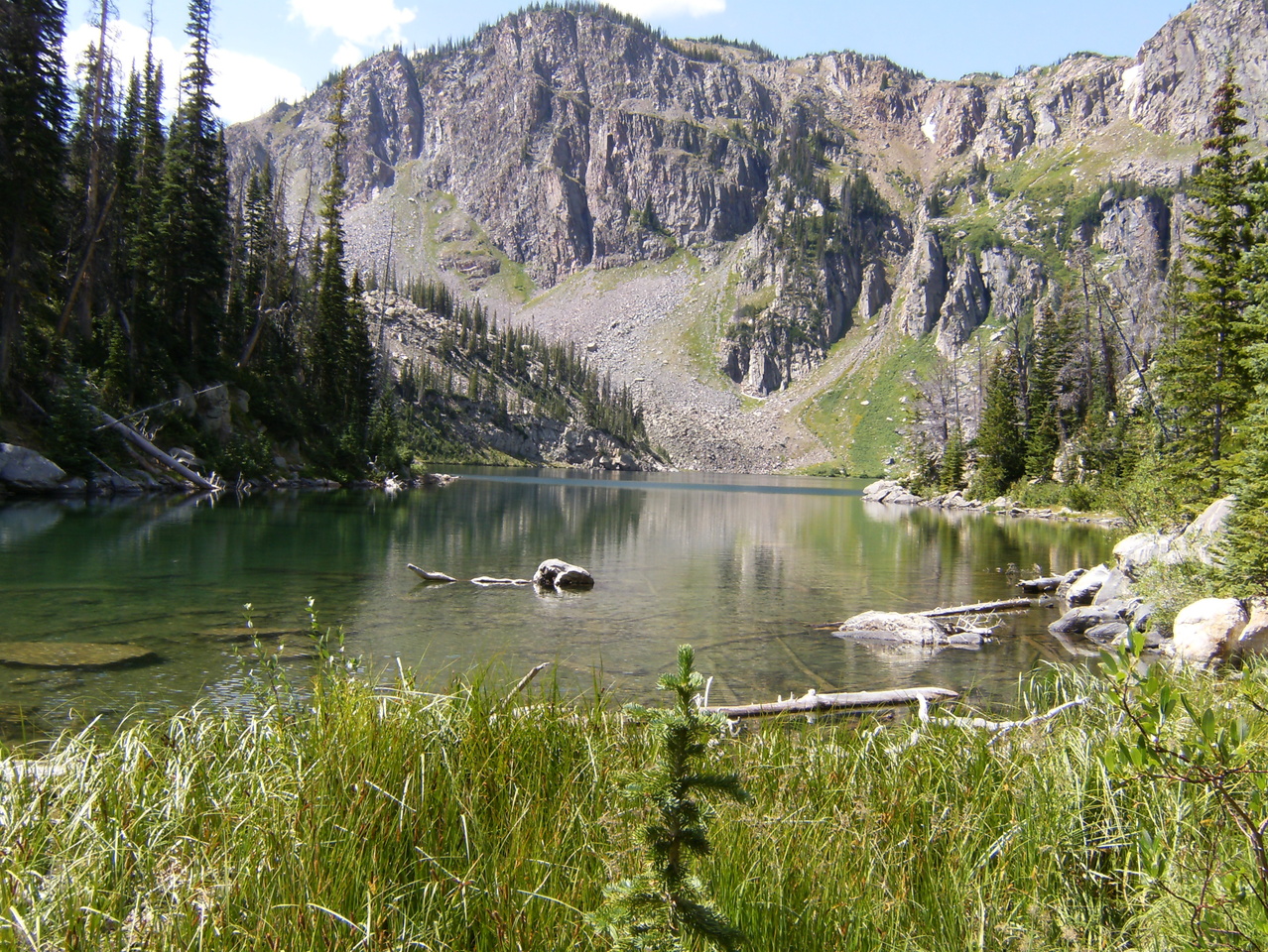
Tiago Lake
Mt. Zirkel Wilderness
See moose, elk, and one of the biggest wildflower displays in Colorado.
Summer comes late to the snowy Park Range at the core of Colorado's Mt. Zirkel Wilderness. But when it arrives, it rushes in with a blaze of wildflower blossoms and a surge of meltwater that turns trickling streams into raging cataracts. Moose frequent the area around Tiago Lake and its nearby twin, Teal Lake. You might even see one from your campsite amid the tall, shade-casting conifers that line the lake. Trails inside the wilderness are arrayed in fishbone fashion, with the Continental Divide Trail as the backbone. Newcomb Creek Trail, at Buffalo Pass (.5 mile north of camp), leads seven miles west through prime elk territory, traversing a broad park and spruce groves to reach the CDT at 10,600 feet. Walk north on the CDT a few miles, gaining 500 feet, to reach open high ground with incredible views of the Rabbit Ears Range and a vast sea of peaks higher than 12,000 feet.
Get there From Hebron, take CR 24 10 miles to the Grizzly Creek Campground. Turn north on FR 615 and go two miles. The first lake on the east side of the road is Tiago.
UTM 40.5839, -106.6052
Map Routt National Forest ($10, USFS)
Contact Medicine Bow-Routt National Forest; (307) 745-2300

Behind-The-Reef
San Rafael Swell
Explore easy southern-Utah slot canyons from camp.
Find abundant car-camping opportunities along the smooth, packed dirt of 3.5-mile Behind-The-Reef Road. Every double-track spur seems to lead through sagebrush to shady juniper and sandstone crags. The available hiking is tight, though. As in tight squeeze. Less than an hour from Green River, this area boasts some of the finest non-technical canyoneering routes in the state. Inside Ding and Dang, Little Wildhorse, Bell, Crack, and Chute Canyons, you’ll slither and clamber through narrow slots of swirling sandstone, no ropes or technical gear required (but bring Hiking and Exploring Utah’s San Rafael Swell, by Michael Kelsey). After you get your fill, drive 20 minutes (give or take, depending on your site) to Goblin Valley State Park to tour a sea of ghoulish hoodoos. Camping tip: For max privacy, look for pull-offs away from the mouths of canyons, which attract crowds. Local LNT rules: Use a previously compacted spot, and pack out all waste.
Get there From the UT 24/Temple Rd. junction, take Temple Rd. west 7.2 miles to unsigned “Behind-the-Reef-Road” on the left.
Coordinates 38.6675, -110.6880
Map San Rafael Swell ($12, National Geographic Maps)
Contact Utah BLM; (435) 636-3600

Forest Road 10
Green Mountain National Forest
Trek classic Vermont trails to secluded swimming holes.
We have nothing against dairy cows and picturesque villages, but the best of Vermont lies in the hills above these quaint scenes. Ascend Forest Road 10 east of Danby into the Green Mountains to explore the Appalachian backbone of Vermont. Past the intersection with the Appalachian Trail/Long Trail, the road becomes gravel and the plush pull-off campsites with flat tent sites atop veritable mattresses of duff much less frequented. Hike the AT/LT north from the road two miles to reach prime swimming on the west shore of Little Rock Pond, surrounded by gentle oak and maple hills and large boulders. Continue to VT 140 to pass the blinding quartzite outcrops and big views atop 3,176-foot White Rocks Mountain for an 11-mile round-trip. Next day, hike the 10-mile Old Job-Long Trail loop beside Lake Brook and up Baker Peak’s rock slabs (located off the McGinn Brook Crossing, south of the campsite). Chill out with a swim in crystalline Griffith Lake at the halfway point, or wait until trail’s end for Big Branch’s bracing pools.
Get there From VT 7 in Danby, turn east onto Brooklyn Rd. (FR 10) and drive approximately 3.5 miles to the Appalachian/Long Trail crossing.
Coordinates 43.3728, -72.9629
Map Vermont’s Long Trail ($10, Green Mountain Club)
Permit None required below 2,500 feet.
Contact Green Mountain Club; (802) 244-7037

Green Road
Nordhouse Dunes Wilderness Area
Enjoy Caribbean-style beach camping on Michigan’s north shore.
A cerulean sea, a desolate beach pounded by big surf, and ranks of giant white dunes do not come to mind when someone utters the word “Michigan.” Which is why Nordhouse Dunes is among the top backcountry wonders of mid-America. From one of several pull-out campsites (stunted pine-bordered plots of white sand) along rough Green Road (FR 5356) on the wilderness’s eastern boundary, explore 20 miles of established, unmarked trails. The routes climb sand hills, skirt marshes and shallow lakes, and ford intermittent streams.As you head west toward Lake Michigan, the dunes transition from oldest to youngest as pine and oak give way to grasses, and then bare, wind-whipped sand.
Get there From Manistee, take US 31 4.9 miles south to County Line Rd. Turn right, and go 1.2 miles to Quarterline Rd., which leads 3.2 miles to a right on West Forest Trail Rd. In four miles, turn left on Green Rd. Find sites on the left within two miles.
Coordinates 44.0852, -86.4126
Map Huron-Manistee NF ($8, USFS)
Contact Huron-Manistee National Forests; (800) 821-6263

Backcountry Canaan Loop Road
Canaan Mountain
Escape the Dolly Sods crowds in this alpine sanctuary.
The brutal winters and frequent wind in this part of West Virginia are more typical of Québec than the Mid-Atlantic. Stunted conifers hold on for dear life, while rock promontories open views of distant ranges and river valleys. 20 miles west of the popular Dolly Sods, Canaan Mountain Backcountry shed's The Sods’ crowds but not the alpine magnetism. This site is a favorite of Johnny Molloy, who wrote Day and Overnight Hikes: West Virginia’s Monongahela National Forest. “Some of the best high-country car camping sites I’ve found anywhere in the country are up where Forest Road 13 (Canaan Loop Road) intersects the eight hiking trails and multiple peaks of Canaan Mountain,” he says. Plus, the campsites offer a meadow-pine matrix seldom seen in the East. The area’s 13,532 acres harbor miles of interconnected trails that create a nearly endless array of dayhikes. The best of the best: White Rim Rocks, Table Rock Overlook, the rim at Blackwater River Gorge, and the bushwhack to Mozark Mountain.
Get there Take WV 32 south 3.3 miles from the Blackwater River bridge in Davis to a large sign pointing to “#1 Wilderness Road.” This is the Canaan Loop Rd.; high clearance recommended. Access crosses private land.
Call Allegheny Wood Products (304-257-1082) to secure permission before traveling on the northern portion of the road.
Coordinates 39.0616, -79.5563
Map USGS Quad Blackwater Falls ($8)
Contact Monongahela National Forest; (304) 636-1793
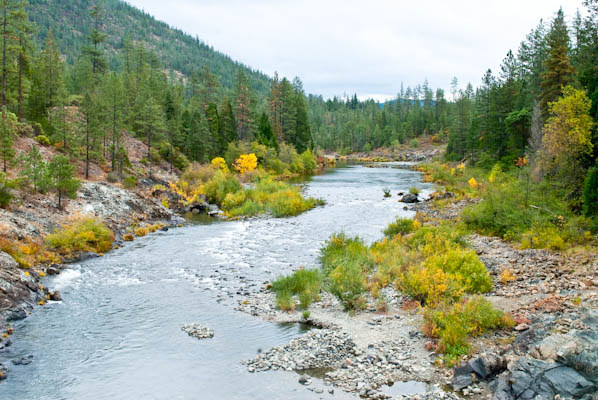
Forest Road 20
Rouge-Siskiyou National Forest
Score Mt. Shasta views and Oregon wildflowers.
Even from a distance of 55 miles, 14,162-foot Mt. Shasta awes. Fixing the giant mountain squarely in sight is one of your goals while shopping campsites on the Siskiyou Crest in southern Oregon. The other? Proximity to the Pacific Crest Trail. You’ll find plenty of opportunities to fulfill both objectives from Mt. Ashland Campground and pull-offs along smooth Forest Road 20, which plays tag with the PCT for some 20 miles. This might just be the best established camping in America. Each campsite offers clusters of big-diameter firs, alpine grasses and meadows, and rocky jumbles of volcanic rock boulders. It’s free, and traffic is light. Too busy for your taste? Just head down the road for more options. Views from camp are of the rocky crest of Mt. Ashland to the north and the snowy crown of Mt. Shasta (in California) to the south. Snow-capped peaks may dominate the skyline, but from late June through July, the subalpine wildflowers are the Siskiyous’ real treasure: Enjoy a rainbow of colors from monkshood, penstemon, Indian paintbrush, larkspur, beargrass, and phlox. Hike the PCT south for more blown-open views from Siskiyou Pass and 6,800-foot Big Red Mountain.
Get there From I-5 south of Ashland, take exit 6 and head west, following the signs to Mt. Ashland. Go .7 mile, then turn right on Mt. Ashland Rd./FR 20 and follow it for 9.3 miles to reach the campground.
Coordinates 42.0755, -122.7145
Map Rogue River National Forest ($9, USFS)
Contact Rogue River-Siskiyou National Forest; (541) 618-2200

Hurricane Creek Road
Mt. Rogers NRA
Camp near Virginia’s highest point.
Appalachian Trail thru-hikers know the balds and wind-beaten pines crowning 5,729-foot Mt. Rogers and its surrounding uplands as the highest country they’ll encounter between the Roan Highlands in North Carolina and the Presidential Range in New Hampshire. Little-known secret: Car campers can experience this same big-sky country, minus the 40-pound pack and ramen dinners. Simple plan: Find a pull-out campsite along the twisting, gravel Forest Road 84, aka “Hurricane Road,” on the north side of Hurricane Mountain, and you’ll have a weekend getaway with easy-access high country hiking. Target a 14.8-mile loop from nearby Grindstone Campground using the Mt. Rogers, Appalachian, and Old Orchard Trails for a greatest-hits tour of rhododendron-choked hollows and grassy balds. From the campground, you’ll climb to Mt. Rogers’s shoulder for widescreen views of Whitetop and Iron Mountains. Turn southeast onto the AT at Deep Gap, take a .5-mile spur to summit tree-covered Mt. Rogers, and then follow the AT over blocky Wilburn Ridge before looping back to Grindstone.
Get there From Trout Dale, take VA 16 2.6 miles north to a left on Comers Creek Rd. Go 1.4 miles to a left on Hurricane Creek Rd. Begin scouting for pull-outs.
Coordinates 36.7210, -81.4816
Map Mt. Rogers ($12, National Geographic Maps)
Contact George Washington and Jefferson National Forests; (540) 265-5100

Glen Canyon National Recreation Area
Slickrock Sanctuary
You wouldn’t blink if we told you this hiker spent three days on the trail to arrive at this slice of heaven. But he only walked 100 feet from his car to the shore of Utah’s Lake Powell. The Hite campground, 10 minutes west of Hite Crossing on UT 95 in glen canyon national recreation area, has no designated sites and costs just $6 per night. Glen Canyon National Recreation Area; (435) 684-2457


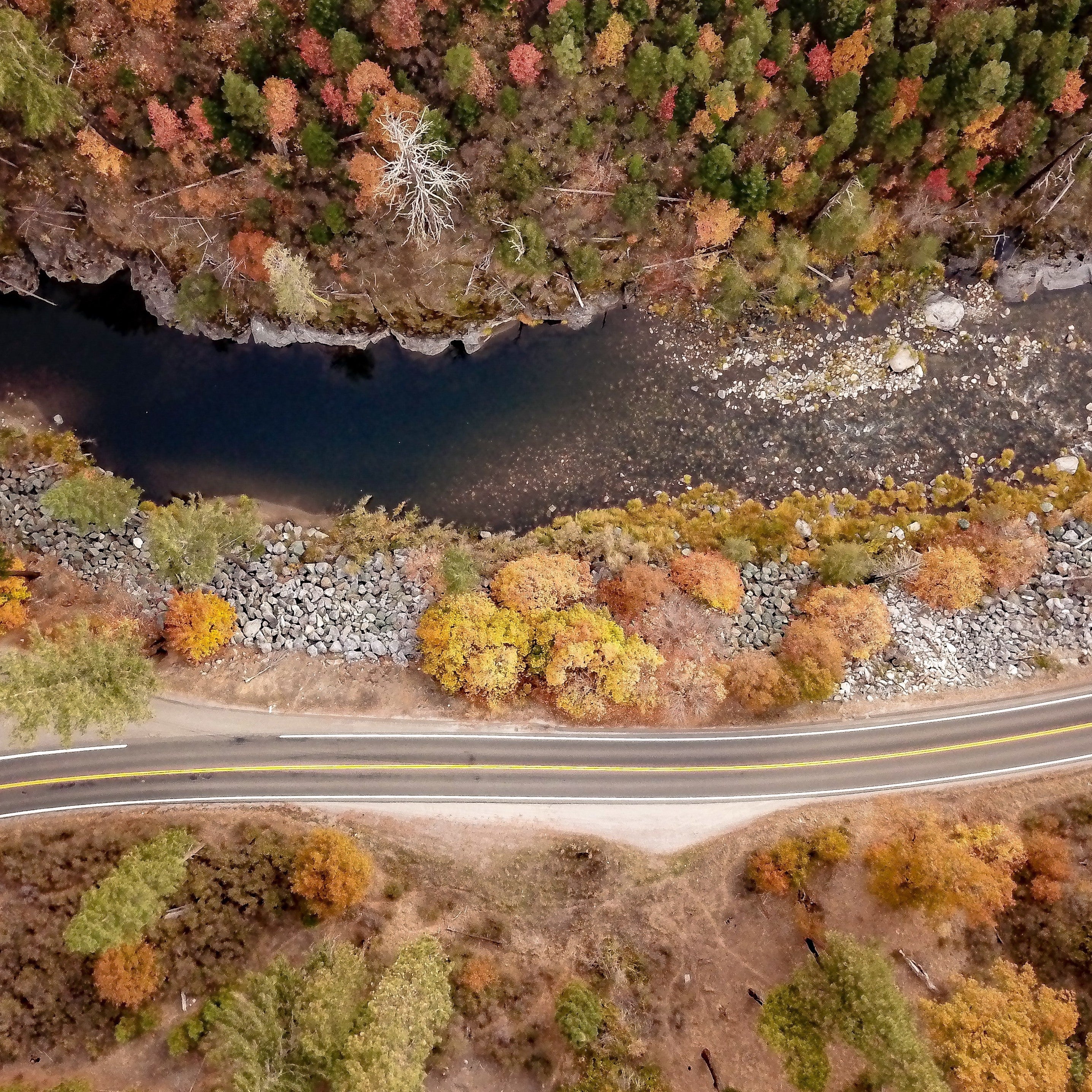


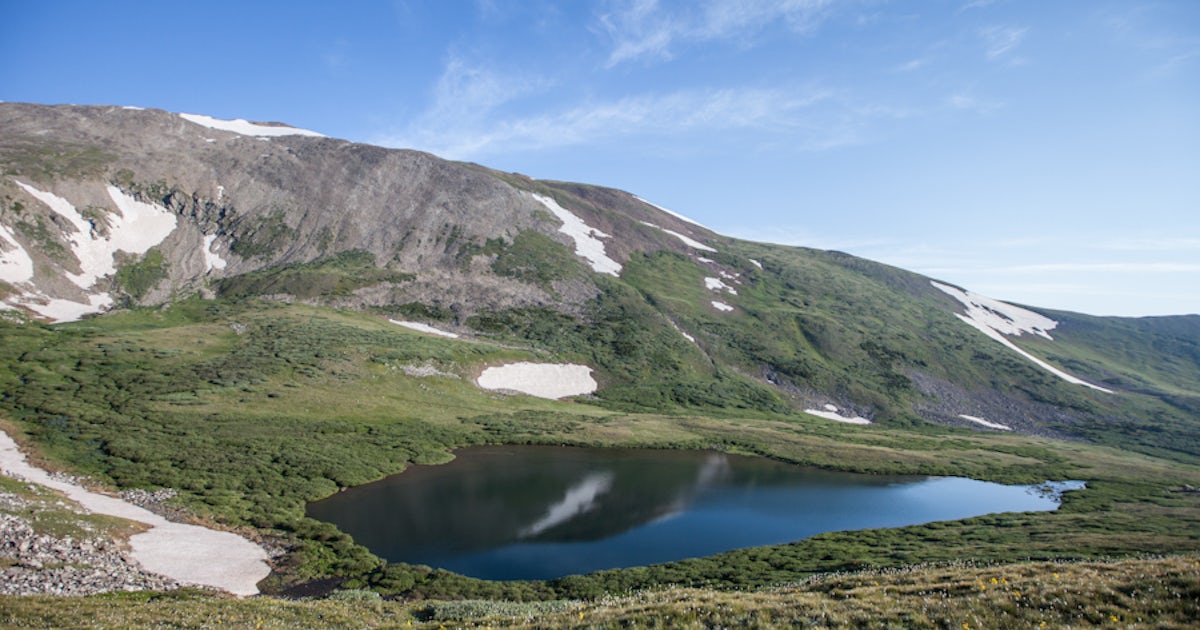


Leave a comment
This site is protected by reCAPTCHA and the Google Privacy Policy and Terms of Service apply.